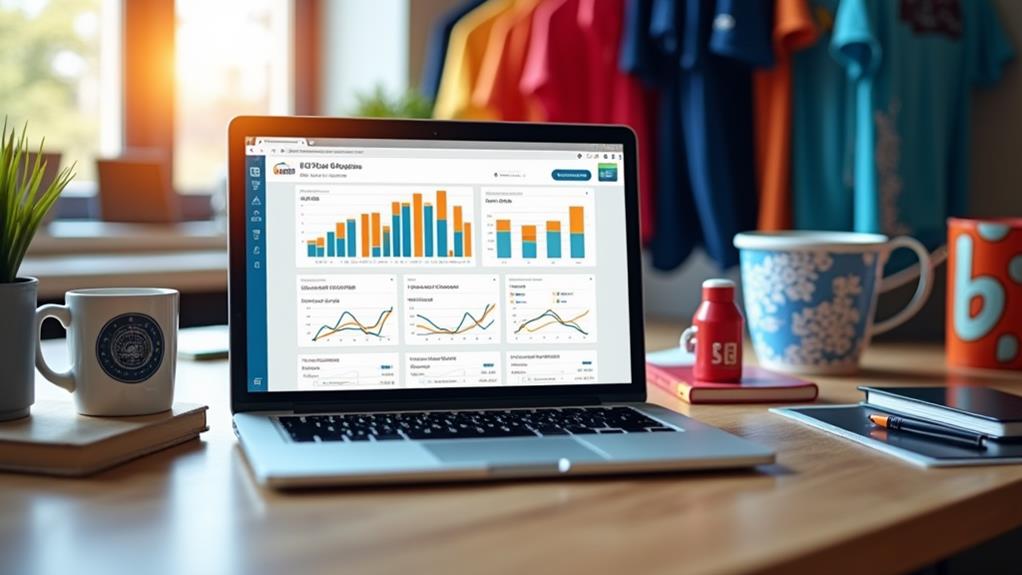
Optimizing your print on demand store for SEO involves several strategic actions to enhance search visibility and drive organic traffic. Start with thorough keyword research to integrate high-demand keywords into product titles, descriptions, and meta tags. Focus on user intent to guarantee content relevance, which improves engagement and rankings. Regularly update product descriptions with keywords, optimize images using descriptive file names and alt tags, and assure mobile optimization for better user experience. Building quality backlinks through guest blogging and using SEO tools like Google Keyword Planner can further boost your efforts. These steps can markedly enhance your store's performance and results. Explore detailed techniques to drive even greater success.
Key Takeaways
- Conduct thorough keyword research and integrate relevant long-tail keywords into product titles, descriptions, and meta tags.
- Optimize product descriptions with engaging, keyword-rich content that aligns with user intent and search queries.
- Ensure mobile optimization with fast loading speeds, responsive design, and minimal pop-ups to enhance user experience.
- Regularly update and audit image file names and alt tags, ensuring they are descriptive and keyword-rich.
- Build quality backlinks through guest blogging and collaborations with authoritative niche websites and influencers.
Importance of SEO for POD
In the competitive landscape of Print on Demand (POD) businesses, the importance of SEO cannot be overstated. Leveraging current SEO trends is vital for enhancing online visibility, which directly impacts search engine rankings and organic traffic.
Studies have shown that 94% of users prefer organic results over paid ads, demonstrating that effective SEO strategies are essential for engaging your target audience. Optimizing content for Featured Snippets can also greatly improve visibility, as these appear in 19% of search results and drive substantial traffic to top-ranking pages.
A well-optimized POD store can greatly boost sales, as higher rankings are correlated with increased conversion rates, averaging around 1.62% for e-commerce sites. This underscores the necessity of SEO for capturing and converting potential customers.
Continuous SEO practices not only drive traffic but also establish credibility and trust, fostering long-term customer retention and loyalty.
Furthermore, implementing SEO techniques reduces dependency on costly paid advertising, offering a sustainable and cost-effective approach to business growth. By focusing on SEO trends and understanding the behavior of your target audience, POD businesses can create a robust online presence that not only attracts but also retains customers.
Consequently, SEO is a pivotal element that can lead to considerable increases in both traffic and sales, ensuring long-term success in the competitive POD market.
Understanding Search Engines
Understanding search engines is pivotal for optimizing a Print on Demand store, as these platforms prioritize content that aligns with user intent and query relevance.
By accurately matching keywords and continuously updating content to reflect search engine algorithms and user behavior, POD stores can markedly improve their visibility.
High-quality, engaging content that meets specific user needs not only enhances user experience but also boosts search engine rankings.
Additionally, incorporating structured data usage and monitoring key SEO metrics such as site speed and mobile optimization can further enhance a store's performance and visibility.
User Intent Importance
Recognizing user intent is paramount for optimizing your Print on Demand store, as it bridges the gap between what potential customers are searching for and what your business offers. Understanding user behavior and intent signals is critical in aligning your content with customer needs, leading to higher engagement and conversion rates.
When users search for specific terms like "home alone Christmas jumper," search engines interpret these queries to identify purchasing intent, emphasizing the necessity for relevant product offerings on your site.
The relevance of your content to user intent considerably impacts your search engine rankings. Well-aligned store and product pages enhance visibility on search engine results pages (SERPs). Effective SEO strategies must incorporate keyword research that reflects user intent, guaranteeing that product titles, descriptions, and other content meet customer expectations.
By accurately interpreting user intent, you can create compelling, targeted content that improves the overall user experience.
Ultimately, a focus on user intent drives organic traffic to your Print on Demand store, enhancing engagement and boosting sales. This user-focused, data-driven approach to SEO guarantees your business remains competitive in the crowded e-commerce landscape.
Content Relevance Factors
A thorough grasp of user intent naturally leads into the critical exploration of content relevance factors, which are vital in optimizing your Print on Demand store for search engines. Search engines prioritize content relevance to user queries, meaning aligning your product pages with specific terms and phrases customers use is essential for visibility. Understanding search intent, such as distinguishing between informational and transactional searches, helps tailor content that meets users' needs effectively.
For example, a search for "home alone christmas jumper" indicates a transactional intent to purchase, highlighting the importance of having product pages that serve this intent. Integrating relevant keywords naturally throughout product descriptions and titles not only aids in SEO but also enhances user engagement by providing clear information about the product.
Continuous monitoring and adjusting content based on evolving search trends and user behavior data is necessary for maintaining content freshness and achieving higher rankings in search results.
| Factor | Description | Impact on SEO |
|---|---|---|
| Keyword Integration | Using relevant keywords in descriptions and titles | Improves search visibility |
| Search Intent | Tailoring content to match user intent | Enhances user engagement |
| Content Freshness | Regularly updating content to reflect trends | Maintains relevance and ranking |
Accurate Query Matching
Successful optimization of a Print on Demand store hinges on the principle of accurate query matching, where search engines prioritize delivering content that closely aligns with user search queries. This alignment enhances user satisfaction and engagement, driving more relevant traffic to your site.
Accurate interpretation of search intent, such as identifying specific terms like "home alone Christmas jumper," is paramount for matching users with suitable products. Engaging in thorough query analysis allows you to understand the search patterns of potential customers.
Utilizing keyword research tools can pinpoint the exact terms and phrases your target audience employs when seeking products. By optimizing your store and product pages to reflect these user queries, you greatly increase the likelihood of appearing in relevant search results.
Ensuring that title tags, descriptions, and product content are meticulously aligned with user intent can considerably improve both search engine rankings and click-through rates. This user-focused strategy not only boosts visibility but also fosters higher engagement and conversions.
Fundamentally, the effectiveness of your Print on Demand store's SEO hinges on a deep understanding of query analysis and search patterns, ultimately leading to a more successful online presence.
User Intent and Relevance

Understanding user intent and ensuring content relevance are paramount for optimizing your print on demand store for SEO. Recognizing user behavior and search patterns is essential for creating content that aligns with what customers are actively searching for.
For instance, if users search for "custom graphic tees," your store should feature titles and descriptions that specifically highlight custom graphic tees to meet that intent. The relevance of content directly influences search engine rankings, making it vital that your product pages match the keywords customers are using.
To further enhance your SEO efforts, consider engagement and community building strategies to retain and attract more users. Data shows that 94% of users prefer organic search results over paid ads, reinforcing the importance of matching user intent with relevant, quality content to attract potential customers.
By continuously analyzing keyword performance and adjusting your content to reflect evolving user intent, you can enhance visibility and drive organic traffic to your print on demand store.
Key strategies to optimize for user intent and relevance include:
- Analyzing user behavior to understand what they are searching for.
- Using search patterns to align content with user queries.
- Creating detailed product descriptions that match keywords.
- Regularly updating content to reflect evolving user intent.
- Monitoring keyword performance to adjust and refine your SEO strategy.
Keyword Research Basics
Conducting thorough keyword research forms the foundation of an effective SEO strategy for your print on demand store. Identifying the terms and phrases that potential customers use to find products can greatly enhance search engine visibility.
Utilizing tools such as Google Keyword Planner and Keywords Everywhere can assist in discovering relevant keywords, while also providing valuable insights into their search volume and competition levels. Additionally, conducting market research to understand demand and competition within your niche can further refine your keyword strategy, ensuring alignment with market needs.
Keyword trends play an essential role in ensuring your content remains current and aligned with customer search behavior. Regularly updating your keyword research to reflect market trends and seasonal changes can keep your store competitive and relevant.
Additionally, focusing on long-tail keywords—more specific phrases with lower competition—can attract highly targeted traffic, making these keywords particularly important for niche products in your print on demand store.
Competitor analysis is another important aspect of keyword research. By examining the keywords your competitors are targeting, you can identify potential gaps and opportunities in your own strategy.
This data-driven approach allows you to refine your keyword selection, ensuring it's both thorough and competitive. Remember, integrating primary keywords naturally into product titles, descriptions, and meta tags is essential for improving SEO without resorting to keyword stuffing.
Integrating Keywords Effectively

How can you seamlessly integrate keywords into your print on demand store to maximize SEO benefits? Effective keyword placement and maintaining ideal keyword density are vital for enhancing your store's visibility.
Start by conducting thorough keyword research using tools like Google Keyword Planner and Keywords Everywhere to identify high-traffic, relevant keywords. Incorporate primary keywords naturally into your content to avoid keyword stuffing.
Focus on these areas:
- Product Titles: Guarantee primary keywords are present to improve search engine visibility.
- Product Descriptions: Use long-tail keywords to attract targeted traffic and boost conversion rates. Leverage SEO strategies to enhance organic traffic and conversion potential.
- Meta Tags: Integrate relevant keywords in meta descriptions to enhance click-through rates.
- Image Alt Tags: Optimize with pertinent keywords to increase chances of appearing in image search results.
- Performance Analytics: Regularly update and refine your keyword strategy based on performance metrics to align with evolving search behaviors.
Optimizing Title Tags
Title tags play a pivotal role in search engine optimization (SEO) by directly influencing your print on demand store's visibility on search engine results pages (SERPs). To refine title tags effectively, implementing title tag best practices is essential. Confirm each title tag is unique and includes primary keywords to enhance relevance and improve rankings. An ideal length of 50-60 characters is recommended to prevent truncation on SERPs, which can undermine visibility.
Incorporating compelling language usage and strong calls to action in title tags can greatly boost click-through rates (CTR) from search results. However, avoid keyword stuffing, as excessive use can lead to search engine penalties, negatively impacting your store's visibility. Regular updates to title tags based on keyword performance and search trends can help maintain and improve SEO effectiveness over time.
Below is a quick reference table summarizing key title tag best practices:
| Best Practice | Description |
|---|---|
| Unique Title Tags | Confirm each page has a distinct title tag to enhance relevance. |
| Ideal Length | Keep title tags between 50-60 characters to avoid truncation. |
| Compelling Language Usage | Use strong calls to action and engaging language to increase CTR. |
Crafting Product Descriptions

Crafting product descriptions that emphasize key features and benefits is essential for enhancing user engagement and improving SEO performance. By naturally incorporating relevant keywords into detailed 100-300 word descriptions, you can guarantee your content is both informative for potential customers and optimized for search engines.
Using bullet points for clarity and storytelling elements for emotional connection can further reduce bounce rates and boost conversion rates. Additionally, consider integrating interactive quizzes to personalize the shopping experience and gather valuable customer insights.
This approach not only engages users but also helps in fine-tuning your marketing strategies based on real-time feedback.
Highlight Key Product Features
When optimizing your Print on Demand store for SEO, emphasizing key product features through well-crafted product descriptions is essential.
Crafting product descriptions that highlight key features and product benefits can greatly impact consumer decisions, with 70% of shoppers influenced by detailed descriptions. Effective descriptions should not only be informative but also engaging and easily scannable.
To achieve this, consider the following strategies:
- Highlight Key Features: Clearly outline what makes your product unique.
- Detail Product Benefits: Explain how the features translate into tangible benefits for the user.
- Use Bullet Points: Enhance readability by listing features and benefits in bullet points, allowing customers to quickly grasp vital information.
- Incorporate Relevant Keywords: Naturally embed keywords to boost SEO without sacrificing content quality.
- Include Unique Selling Propositions (USPs): Differentiate your product from competitors by emphasizing unique aspects.
Incorporate Natural Language Keywords
Effectively incorporating natural language keywords into your product descriptions is crucial for optimizing your Print on Demand store for SEO. By mimicking customer language, you can create relatable and engaging product descriptions that resonate with your target audience.
Aim for a keyword density of about 1-2% to maintain readability while optimizing for search engines.
Utilize long-tail keywords, which have lower competition and higher conversion rates. For example, specific phrases like "custom graphic t-shirts for dog lovers" can draw in niche markets. Natural language keywords should be seamlessly integrated by highlighting product features and benefits, guaranteeing that descriptions are both informative and engaging. This enhances the user experience and boosts SEO effectiveness.
Regularly updating product descriptions with fresh, relevant keywords based on current trends and customer search behavior can greatly improve search visibility over time.
Analyze customer language and search habits to refine your keyword placement strategy. By doing so, you guarantee that your product descriptions remain relevant and aligned with what potential customers are searching for. This proactive approach not only improves SEO performance but also enhances customer satisfaction and engagement.
Image Optimization Tips
To achieve higher search engine rankings and provide an ideal user experience, image optimization is an essential element for any print-on-demand store. Effective image optimization can greatly enhance your SEO performance and guarantee that your site is both user-friendly and accessible.
By focusing on image optimization, you can also improve your site's performance, which is vital for retaining mobile users who expect fast loading times.
- Image file naming: Use descriptive and keyword-rich file names for your images. For instance, "custom-christmas-mug.jpg" is far superior to "IMG_1234.jpg" regarding search engine relevance.
- Alt tag implementation: Implement alt tags for every image, incorporating relevant keywords. This not only provides context for search engines but also enhances accessibility for visually impaired users.
- Image size optimization: Optimize image file sizes to guarantee fast loading times. Given that 53% of mobile users abandon sites that take longer than 2 seconds to load, this step is vital for improving user experience and SEO performance.
- Responsive image techniques: Utilize responsive image techniques by using different sizes for various devices. This guarantees that images display correctly on all screen sizes, enhancing mobile optimization.
- Broken link audits: Regularly audit images for broken links or missing alt tags. Addressing these issues promptly can prevent negative impacts on SEO and user experience, thereby maintaining your traffic.
For more insights on how to optimize your print-on-demand store, consider using sophisticated data visualization tools to refine your strategy.
Utilizing SEO Tools

A multitude of SEO tools are essential for optimizing your print-on-demand store, enabling you to gain a competitive edge in the digital marketplace. Keyword analysis is fundamental to this process, and tools like Google Keyword Planner and Serpstat provide invaluable insights into keyword performance and competition evaluation. By leveraging these tools, you can identify high-ranking keywords that will drive traffic to your store.
Additionally, engaging actively on social media platforms can foster trust and credibility, seamlessly integrating your SEO efforts for better results.
Moreover, Google Trends enables you to track the popularity of search terms over time, allowing you to create content that aligns with current customer interests and market trends. This data-driven approach guarantees that your store remains relevant and engaging.
To further improve your SEO strategy, utilizing automated SEO audit tools can identify areas for improvement in your store's current setup. These audits offer actionable insights that can enhance your store's visibility and search engine ranking.
Additionally, analytics platforms are vital for measuring site performance and user engagement. This information can inform necessary adjustments to your marketing strategies, ultimately enhancing the overall customer experience.
Mobile Optimization Strategies
Expanding the scope of your SEO strategy beyond tools and analytics is essential for achieving a competitive edge in the digital marketplace. Mobile optimization strategies are indispensable, especially given that approximately 80% of users search via smartphones.
Adopting effective mobile design guarantees your print on demand store not only ranks higher in Google's mobile-first indexing but also provides a superior user experience. Speed is vital; 53% of users abandon sites that take longer than 2 seconds to load. Consequently, optimizing loading speed is non-negotiable.
Implementing responsive design is key to adapting seamlessly to various screen sizes, enhancing both user accessibility and satisfaction. Additionally, reducing pop-ups and minimizing content on mobile pages can greatly lower bounce rates, leading to higher engagement and conversion rates.
Utilizing user-friendly interfaces from platforms like Shopify can further enhance the mobile user experience by simplifying navigation and customization. Regular performance testing using tools like Google PageSpeed Insights is important for pinpointing areas for improvement.
This guarantees your mobile site maintains peak functionality, providing a smooth shopping experience.
- Optimize mobile design for various screen sizes
- Enhance loading speed to retain users
- Implement responsive design for better user experience
- Minimize pop-ups and reduce content on mobile pages
- Conduct regular performance testing with Google PageSpeed Insights
These strategies collectively guarantee your mobile optimization efforts are robust and effective.
Building Quality Backlinks

Building quality backlinks is essential for enhancing your print on demand store's SEO performance.
Guest blogging on authoritative niche websites and leveraging social media strategies to share valuable content can generate high-quality backlinks, driving both credibility and traffic.
Collaborating with content creators to enrich your brand narrative can also attract backlinks from reputable sources.
Guest Blogging Opportunities
Guest blogging offers an exceptional opportunity to improve your print on demand store's SEO by building high-quality backlinks. Implementing effective guest posting strategies on reputable niche blogs can greatly raise your site's authority.
By securing these valuable backlinks, you enhance your search engine ranking, driving more organic traffic to your store.
To maximize the benefits, consider the following:
- Target High DA Blogs: Focus on niche blogs with high domain authority (DA) scores. Backlinks from these sites are more impactful in search engine algorithms.
- Showcase Expertise: Use guest blogging to demonstrate your expertise, which not only builds credibility but also attracts a targeted audience to your print on demand store.
- Include Relevant Links: Within your guest posts, integrate relevant links to your store. Confirm your author bio is compelling and includes a link to boost visibility.
- Consistent Participation: Regular contributions can establish your brand as a thought leader, fostering trust and customer loyalty.
- Drive Targeted Traffic: Quality guest blogs can drive targeted traffic, increasing the potential for sales and enhancing brand recognition.
Social Media Strategies
Leveraging social media strategies is essential for building quality backlinks to your print on demand (POD) store, greatly enhancing your SEO efforts. Engaging in relevant online forums and communities is a vital tactic. By sharing valuable insights and appropriately linking back to your POD store, you generate organic, high-quality backlinks that bolster your search engine rankings.
Influencer collaborations are another powerful method. Partnering with influencers in your niche can yield backlinks from their platforms, markedly elevating your store's visibility and authority. These collaborations often lead to increased social media engagement, driving more traffic to your store.
Guest posting on reputable blogs related to your industry is an effective way to secure quality backlinks. When you include links back to your POD store in these posts, you not only drive traffic but also enhance your SEO through improved backlink profiles.
Creating shareable content, such as infographics or how-to guides, further amplifies this effect. Such content encourages other websites to link to your store, enriching your backlink portfolio.
Consistently monitoring your backlink profile using tools like Ahrefs or Moz is essential. These tools help identify valuable backlinks and uncover opportunities for further collaboration or content creation, ensuring sustained SEO success.
Frequently Asked Questions
How Do You Optimize Copies for SEO?
To optimize copies for SEO, conduct thorough keyword research to inform your content strategy. Integrate primary keywords naturally, use bullet points for readability, craft unique descriptions, and update content regularly based on performance data and trends.
How Do I Make My Print on Demand Successful?
To make your print on demand store successful, identify your target audience and implement effective marketing strategies. Utilize data-driven insights to optimize product offerings, enhance user experience, and continually refine your approach for sustained growth and customer engagement.
How Do I Optimize My Product Image for SEO?
To optimize your product images for SEO, use descriptive, keyword-rich file names and implement image alt tags. This practice enhances search engine understanding and accessibility, while also improving user experience and boosting your store's visibility.
How Can I Improve My Store SEO?
To improve your store SEO, conduct thorough keyword research to identify relevant terms, and implement a robust content strategy. Regularly update product descriptions, optimize images, and build high-quality backlinks to enhance search engine visibility and user engagement.
Conclusion
Optimizing a print-on-demand store for SEO is essential for visibility and profitability. Understanding search engines, user intent, and relevance helps in crafting effective strategies. Conducting thorough keyword research and integrating keywords seamlessly into content enhances search rankings. Image optimization, utilizing SEO tools, and mobile optimization further boost performance. Building quality backlinks strengthens domain authority. A data-driven, user-focused approach guarantees sustained growth and competitive advantage in the digital marketplace.
Leave a Reply